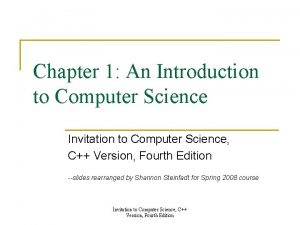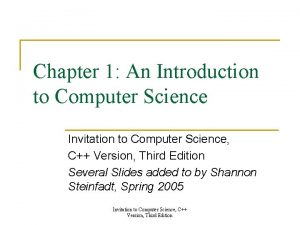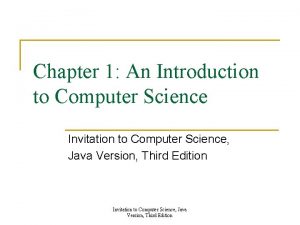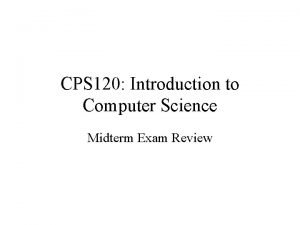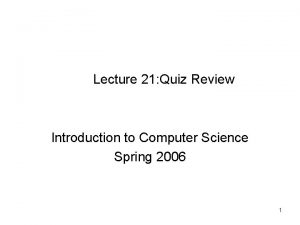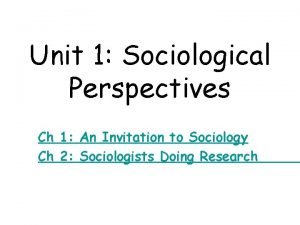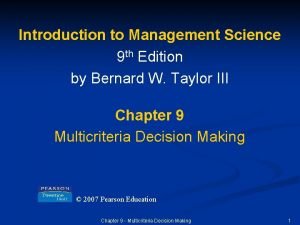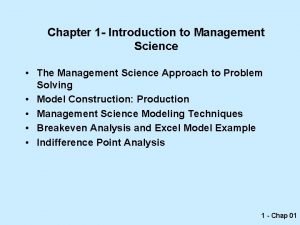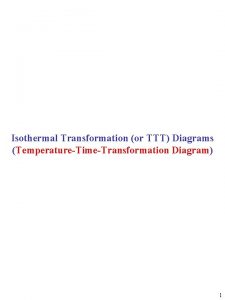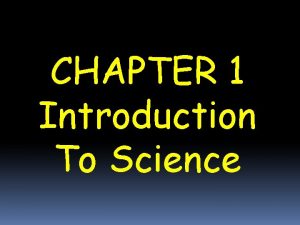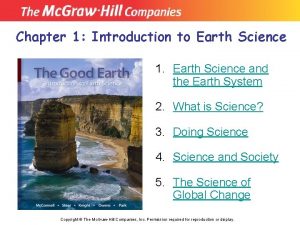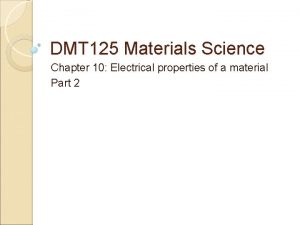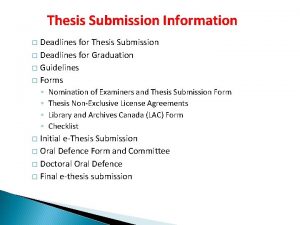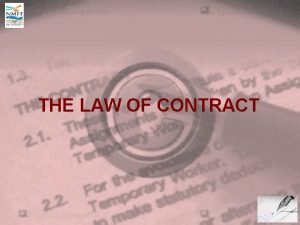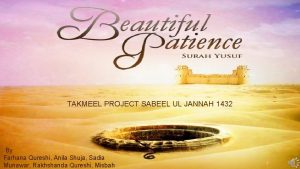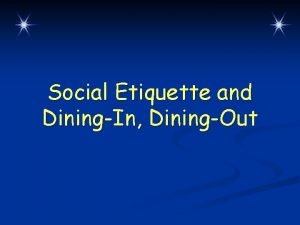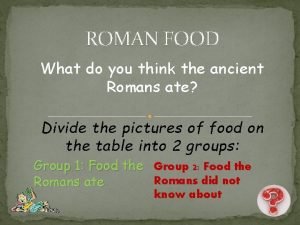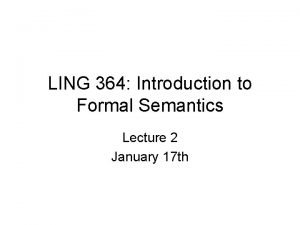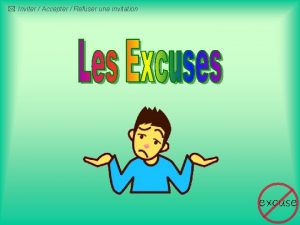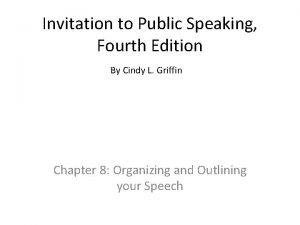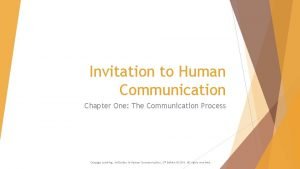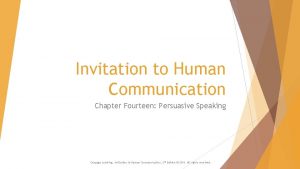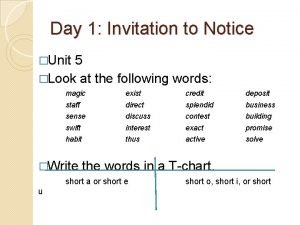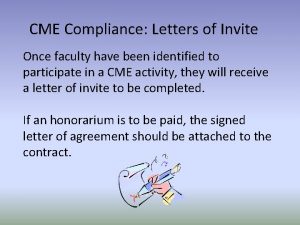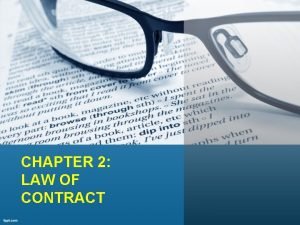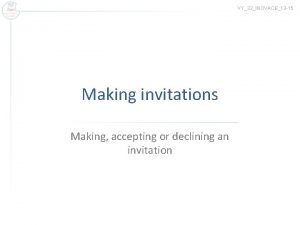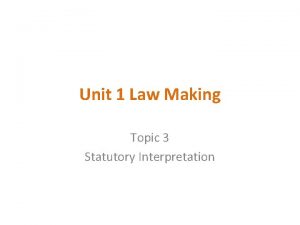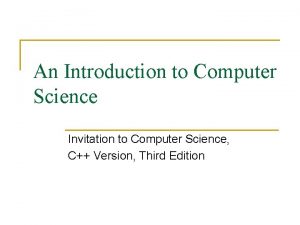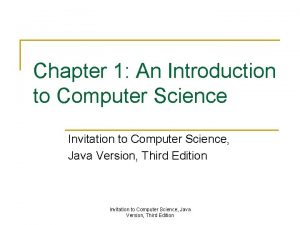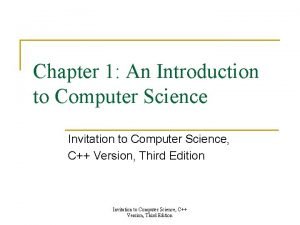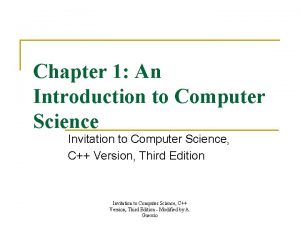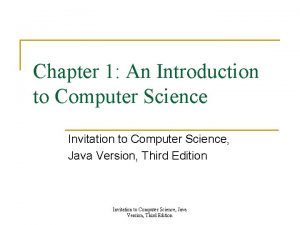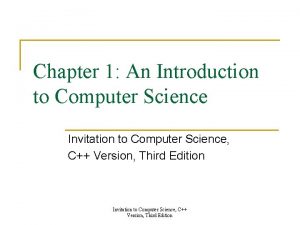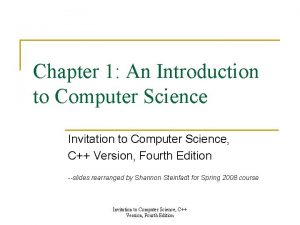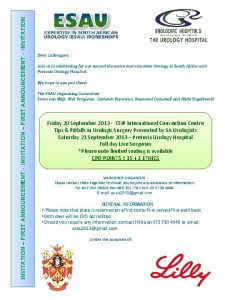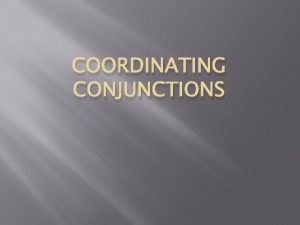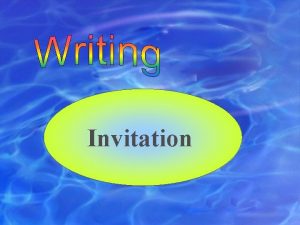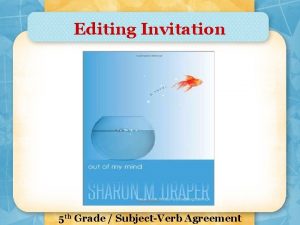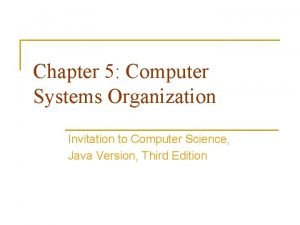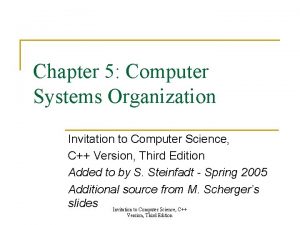Chapter 1 An Introduction to Computer Science Invitation









































- Slides: 41

Chapter 1: An Introduction to Computer Science Invitation to Computer Science, Java Version, Third Edition

Objectives In this chapter, you will learn about n The definition of computer science n Algorithms n A brief history of computing n Organization of the text Invitation to Computer Science, Java Version, Third Edition 2

Introduction n Common misconceptions about computer science q q q Computer science is the study of computers Computer science is the study of how to write computer programs Computer science is the study of the uses and applications of computers and software Invitation to Computer Science, Java Version, Third Edition 3

The Definition of Computer Science n Gibbs and Tucker definition of computer science q The study of algorithms n Formal and mathematical properties n Hardware realizations n Linguistic realizations n Applications Invitation to Computer Science, Java Version, Third Edition 4

The Definition of Computer Science (continued) n Computer scientist designs and develops algorithms to solve problems n Operations involved in designing algorithms q Formal and mathematical properties n q Studying the behavior of algorithms to determine whether they are correct and efficient Hardware realizations n Designing and building computer systems that are able to execute algorithms Invitation to Computer Science, Java Version, Third Edition 5

The Definition of Computer Science (continued) q Linguistic realizations n q Designing programming languages and translating algorithms into these languages Applications n Identifying important problems and designing correct and efficient software packages to solve these problems Invitation to Computer Science, Java Version, Third Edition 6

The Definition of Computer Science (continued) n Algorithm q q Dictionary definition n Procedure for solving a mathematical problem in a finite number of steps that frequently involves repetition of an operation n A step-by-step method for accomplishing a task Informal description n An ordered sequence of instructions that is guaranteed to solve a specific problem Invitation to Computer Science, Java Version, Third Edition 7

The Definition of Computer Science (continued) n An algorithm is a list that looks like q q q q STEP 1: Do something. STEP 2: Do something. STEP 3: Do something. . . . STEP N: Stop. You are finished. Invitation to Computer Science, Java Version, Third Edition 8

The Definition of Computer Science (continued) n Categories of operations used to construct algorithms q Sequential operations n n Carry out a single well-defined task; when that task is finished, the algorithm moves on to the next operation Examples: q Add 1 cup of butter to the mixture in the bowl q Subtract the amount of the check from the current account balance q Set the value of x to 1 Invitation to Computer Science, Java Version, Third Edition 9

The Definition of Computer Science (continued) q Conditional operations n Ask a question and then select the next operation to be executed on the basis of the answer to that question n Examples q If the mixture is too dry, then add one-half cup of water to the bowl Invitation to Computer Science, Java Version, Third Edition 10

The Definition of Computer Science (continued) n Conditional operations examples (continued): q If the amount of the check is less than or equal to the current account balance, then cash the check; otherwise, tell the person that the account is overdrawn q If x is not equal to 0, then set y equal to 1/x; otherwise, print an error message that says we cannot divide by 0 Invitation to Computer Science, Java Version, Third Edition 11

The Definition of Computer Science (continued) q Iterative operations n Tell us to go back and repeat the execution of a previous block of instructions n Examples q Repeat the previous two operations until the mixture has thickened q While there are still more checks to be processed, do the following five steps q Repeat steps 1, 2, and 3 until the value of y is equal to 11 Invitation to Computer Science, Java Version, Third Edition 12

The Definition of Computer Science (continued) n If we can specify an algorithm to solve a problem, we can automate its solution n Computing agent q q The machine, robot, person, or thing carrying out the steps of the algorithm Does not need to understand the concepts or ideas underlying the solution Invitation to Computer Science, Java Version, Third Edition 13

The Formal Definition of an Algorithm q n A well-ordered collection of unambiguous and effectively computable operations that, when executed, produces a result and halts in a finite amount of time Unambiguous operation q An operation that can be understood and carried out directly by the computing agent without needing to be further simplified or explained Invitation to Computer Science, Java Version, Third Edition 14

The Formal Definition of an Algorithm (continued) n A primitive operation (or a primitive) of the computing agent q q q n Operation that is unambiguous for computing agent Primitive operations of different individuals (or machines) vary An algorithm must be composed entirely of primitives Effectively computable q Computational process exists that allows computing agent to complete that operation successfully Invitation to Computer Science, Java Version, Third Edition 15

The Formal Definition of an Algorithm (continued) n The result of the algorithm must be produced after the execution of a finite number of operations q Infinite loop n The algorithm has no provisions to terminate n A common error in the designing of algorithms Invitation to Computer Science, Java Version, Third Edition 16

The Importance of Algorithmic Problem Solving n Algorithmic solutions can be q q n Encoded into some appropriate language Given to a computing agent to execute The computing agent q q Would mechanically follow these instructions and successfully complete the task specified Would not have to understand n n Creative processes that went into discovery of solution Principles and concepts that underlie the problem Invitation to Computer Science, Java Version, Third Edition 17

The Early Period: Up to 1940 n 3, 000 years ago: Mathematics, logic, and numerical computation q n 1614: Logarithms q n Important contributions made by the Greeks, Egyptians, Babylonians, Indians, Chinese, and Persians Invented by John Napier to simplify difficult mathematical computations Around 1622: First slide rule created Invitation to Computer Science, Java Version, Third Edition 18

The Early Period: Up to 1940 (continued) n 1672: The Pascaline q q q n Designed and built by Blaise Pascal One of the first mechanical calculators Could do addition and subtraction 1674: Leibnitz’s Wheel q q q Constructed by Gottfried Leibnitz Mechanical calculator Could do addition, subtraction, multiplication, and division Invitation to Computer Science, Java Version, Third Edition 19

Figure 1. 4 The Pascaline: One of the Earliest Mechanical Calculators Invitation to Computer Science, Java Version, Third Edition 20

The Early Period: Up to 1940 (continued) n 1801: The Jacquard loom q q q n Developed by Joseph Jacquard Automated loom Used punched cards to create desired pattern 1823: The Difference Engine q q q Developed by Charles Babbage Did addition, subtraction, multiplication, and division to 6 significant digits Solved polynomial equations and other complex mathematical problems Invitation to Computer Science, Java Version, Third Edition 21

Figure 1. 5 Drawing of the Jacquard Loom Invitation to Computer Science, Java Version, Third Edition 22

The Early Period: Up to 1940 (continued) n 1830 s: The Analytic Engine q q q Designed by Charles Babbage More powerful and general-purpose computational machine Components were functionally similar to the four major components of today’s computers n n Mill (modern terminology: arithmetic/logic unit) Store (modern terminology: memory) Operator (modern terminology: processor) Output (modern terminology: input/output) Invitation to Computer Science, Java Version, Third Edition 23

The Early Period: Up to 1940 (continued) n 1890: U. S. census carried out with programmable card processing machines q q Built by Herman Hollerith These machines could automatically read, tally, and sort data entered on punched cards Invitation to Computer Science, Java Version, Third Edition 24

The Birth of Computers: 1940 -1950 n Development of electronic, general-purpose computers q q n Did not begin until after 1940 Was fueled in large part by needs of World War II Early computers q q q Mark I ENIAC ABC system Colossus Z 1 Invitation to Computer Science, Java Version, Third Edition 25

Figure 1. 6 Photograph of the ENIAC Computer Invitation to Computer Science, Java Version, Third Edition 26

The Birth of Computers: 1940 -1950 (continued) n Stored program computer model q q q Proposed by John Von Neumann in 1946 Stored binary algorithm in the computer’s memory along with the data Is known as the Von Neumann architecture Modern computers remain, fundamentally, Von Neumann machines First stored program computers n n EDVAC EDSAC Invitation to Computer Science, Java Version, Third Edition 27

The Modern Era: 1950 to the Present n First generation of computing (1950 -1959) q Vacuum tubes used to store data and programs q Each computer was multiple rooms in size q Computers were not very reliable Invitation to Computer Science, Java Version, Third Edition 28

The Modern Era: 1950 to the Present (continued) n Second generation of computing (1959 -1965) q q Transistors and magnetic cores replaced vacuum tubes Dramatic reduction in size n q q q Computer could fit into a single room Increase in reliability of computers Reduced cost of computers High-level programming languages n The programmer occupation was born Invitation to Computer Science, Java Version, Third Edition 29

The Modern Era: 1950 to the Present (continued) n Third generation of computing (1965 -1975) q q q Integrated circuits rather than individual electronic components were used Further reduction in size and cost of computers n Computers became desk-sized n First minicomputer developed Software industry formed Invitation to Computer Science, Java Version, Third Edition 30

The Modern Era: 1950 to the Present (continued) n Fourth generation of computing (1975 -1985) q q Reduced to the size of a typewriter First microcomputer developed Desktop and personal computers common Appearance of n n Computer networks Electronic mail User-friendly systems (graphical user interfaces) Embedded systems Invitation to Computer Science, Java Version, Third Edition 31

Figure 1. 7 The Altair 8800, the World’s First Microcomputer Invitation to Computer Science, Java Version, Third Edition 32

The Modern Era: 1950 to the Present (continued) n Fifth generation of computing (1985 -? ) q Recent developments n Massively parallel processors n Handheld devices and other types of personal digital assistants (PDAs) n High-resolution graphics n Powerful multimedia user interfaces incorporating sound, voice recognition, touch, photography, video, and television Invitation to Computer Science, Java Version, Third Edition 33

The Modern Era: 1950 to the Present (continued) n Recent developments (continued) q Integrated global telecommunications incorporating data, television, telephone, fax, the Internet, and the World Wide Web q Wireless data communications q Massive storage devices q Ubiquitous computing Invitation to Computer Science, Java Version, Third Edition 34

Figure 1. 8 Some of the Major Advancements in Computing Invitation to Computer Science, Java Version, Third Edition 35

Figure 1. 8 Some of the Major Advancements in Computing Invitation to Computer Science, Java Version, Third Edition 36

Organization of the Text n This book is divided into six separate sections called levels n Each level addresses one aspect of the definition of computer science n Computer science/algorithms Invitation to Computer Science, Java Version, Third Edition 37

Organization of the Text (continued) n Level 1: The Algorithmic Foundations of Computer Science q n Level 2: The Hardware World q n Chapters 1, 2, 3 Chapters 4, 5 Level 3: The Virtual Machine q Chapters 6, 7 Invitation to Computer Science, Java Version, Third Edition 38

Organization of the Text (continued) n Level 4: The Software World q n Level 5: Applications q n Chapters 8, 9, 10, 11 Chapters 12, 13, 14 Level 6: Social Issues q Chapter 15 Invitation to Computer Science, Java Version, Third Edition 39

Figure 1. 9 Organization of the Text into a Six-Layer Hierarchy Invitation to Computer Science, Java Version, Third Edition 40

Summary n Computer science is the study of algorithms n An algorithm is a well-ordered collection of unambiguous and effectively computable operations that, when executed, produces a result and halts in a finite amount of time n If we can specify an algorithm to solve a problem, then we can automate its solution n Computers developed from mechanical calculating devices to modern electronic marvels of miniaturization Invitation to Computer Science, Java Version, Third Edition 41
 Invitation to computer science chapter 10 answers
Invitation to computer science chapter 10 answers Invitation to computer science
Invitation to computer science Invitation to computer science
Invitation to computer science Invitation to computer science
Invitation to computer science Your favorite subject
Your favorite subject K5 think central
K5 think central Introduction to computer science midterm exam
Introduction to computer science midterm exam Introduction to computer science midterm exam test
Introduction to computer science midterm exam test Introduction to computer science quiz
Introduction to computer science quiz Python programming an introduction to computer science
Python programming an introduction to computer science Zeta phi beta boule 2022 philadelphia
Zeta phi beta boule 2022 philadelphia Chapter 1 an invitation to sociology answers
Chapter 1 an invitation to sociology answers Computer science illuminated chapter 4 answers
Computer science illuminated chapter 4 answers Introduction to management science chapter 5 solutions
Introduction to management science chapter 5 solutions Introduction to management science chapter 1 solutions
Introduction to management science chapter 1 solutions Introduction to materials science for engineers chapter 10
Introduction to materials science for engineers chapter 10 Chapter 1 introduction to science
Chapter 1 introduction to science Chapter 1 introduction to earth science
Chapter 1 introduction to earth science Introduction to materials science for engineers chapter 10
Introduction to materials science for engineers chapter 10 Chapter 1 intro to forensic science
Chapter 1 intro to forensic science Invitation letter for thesis defense
Invitation letter for thesis defense Invitation to treat
Invitation to treat Takmeel e quran invitation
Takmeel e quran invitation Dave engels
Dave engels Miss cuba receives an invitation
Miss cuba receives an invitation It is polite to rsvp to an invitation within ______ day(s).
It is polite to rsvp to an invitation within ______ day(s). Poor roman food
Poor roman food Ny state of health assistor certification training
Ny state of health assistor certification training Invitation to formal semantics
Invitation to formal semantics Cinderella invitation card
Cinderella invitation card Offer
Offer Refuser l'invitation
Refuser l'invitation Invitation to public speaking
Invitation to public speaking Invitation to human communication
Invitation to human communication Persuasive invitation
Persuasive invitation Informal reply to invitation
Informal reply to invitation Invitation to notice
Invitation to notice Inviteonce
Inviteonce Invitation to treat
Invitation to treat Decline invitation dialogue
Decline invitation dialogue Revision invitation to party
Revision invitation to party London and north eastern railway v berriman
London and north eastern railway v berriman

